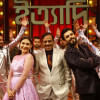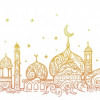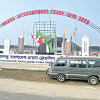Whether you belong to the older generation or the younger one, you are surely familiar with that unmistakable feeling when you wake up on Eid morning. It's a unique blend of grogginess and excitement, where you are still half-asleep but also acutely aware that today is no ordinary day. There's a certain magic in the air, a quiet buzz that seeps into your consciousness even before you fully open your eyes.
The day usually starts with the faint sound of takbir echoing from the mosque, blending seamlessly with the chaos of the household. Women are already up, bustling in the kitchen, the aroma of warm shemai and pulao filling the air. While men may look for their tupi, hurrying to get to the Eidgah with children arguing about who gets to shower first.
In a broader sense, Eid in every household is sacred in their chaotic way.
The excitement of chand raat
"I remember as a child, I would barely sleep the night before Eid," laughs Ayesha Rahman, a schoolteacher. "The anticipation of wearing my new dress, eating all the delicious food, and most importantly, getting salami, made the night almost unbearable!"
Before Eid morning arrives, there is "chand raat", the night when the crescent moon is sighted, confirming the arrival of the much-awaited day. The moment the announcement is made, excitement spills into the streets, markets stay open late into the night, and families begin their final preparations.
In many households, henna application is a ritual. Young girls sit in a circle, taking turns as an elder or a professional artist decorates their hands with intricate floral patterns. The smell of fresh mehendi lingers in the air, a fragrance synonymous with Eid.
Remembering her sister who died a few years ago, Raisa recalls, "Chand raat was our night – she was always the one to apply my mehendi, drawing the most intricate patterns with such patience. I would sit still, watching her work. Now, every Eid, as I trace the designs on my own hands, I can almost hear her laughter. The colour fades, but the memories never do."
As the night stretches on, the excitement settles into a quiet anticipation. New clothes are carefully laid out, elders share stories of Eids gone by, and children struggle to sleep, dreaming of the festivities that await them.
Eid's joyful tune – O mon Romzaner oi rozar sheshe
"I have heard this song every Eid since I was a child," says Mizanur Rahman, a 45-year-old shopkeeper from Shahjadpur. "Even now, when I hear the first few lines, it brings back memories of running to the bazaar with my brothers and fetching groceries for my mother on chand raat."
Like Rahman, many of us may find the celebrations of Eid incomplete without the iconic song. The moment Ramadan ends and the first announcement of Eid is made, this song finds its way into homes and television screens, instantly filling the air with nostalgia and joy.
No matter how old this song might be, it has not lost its charm and the magic lies in its ability to remind people of past Eids, of childhood laughter, of loved ones who are no longer there, and at the same time, it builds anticipation for the joy that is yet to come.
The great Eid heist – Salami
If there is one thing that truly unites every child on Eid, it is the relentless pursuit of salami – the tradition of collecting crisp banknotes from elders with a well-rehearsed, innocent smile.
While the day begins with prayer and reflection, for the younger generation, Eid kicks off when they strategically position themselves near uncles, aunts, and grandparents, hands subtly extended, and ready for the grand payday.
"I still remember how my cousins and I had an unspoken competition – who could collect the most salami by the end of the day?" laughs Alvee, who is now in his 30s and lives in Sweden. "It was all about technique. A well-timed hug, a polite Eid Mubarak, and boom! Another note safely tucked away in our pockets."
The best part? The excitement doesn't fade with age. Even teenagers – who pretend to be too grown-up for it – still eagerly accept the folded salami with a sheepish grin. And then there are the elders who love the tradition just as much as the kids do.
"My grandchildren start hinting about salami days before Eid," chuckles Mahbuba Begum, a grandmother of two. "They sit beside me, all sweet and helpful, waiting for me to reach for my purse. It's adorable, really. And let's be honest, I enjoy giving it as much as they enjoy receiving it!"
While salami might be the highlight for many, the real treasure of Eid is the warmth it brings –the sound of children giggling as they count their earnings, the generosity of elders who give without hesitation, and the simple joy of seeing smiles stretch wide across faces, young and old.
'Eid without Ityadi feels incomplete'
"Every year, Ityadi brings something new, yet it still feels comfortingly familiar," says Ataur Rahman, a father of three. "It's like the polao on the Eid table – you know it's going to be there, and you wouldn't have it any other way. For me, Eid without Ityadi feels incomplete!"
For years, Ityadi has functioned as a cultural glue that connects generations – grandparents, parents, and children all sit together, laughing at the witty satirical sketches and enjoying the heartfelt human-interest stories.
The show's ability to blend humour with social awareness is what makes it stand out. Hanif Sanket masterfully addresses contemporary issues – whether it's corruption, cultural changes, or everyday struggles – with a mix of sarcasm and wisdom that resonates with viewers across all backgrounds.
"My father watches for the political satire, my mother loves the inspirational segments, and I just wait for the hilarious sketches," says Shakib, a 19-year-old from Dhaka. "There's something for everyone, and that's why it never gets old."
As the show ends and the credits roll, there is always a lingering warmth – a sense of satisfaction that another Eid has been celebrated well. Whether in the heart of Dhaka or at a quaint village, whether in a house full of guests or watching from abroad, Ityadi remains the one thing that brings Bangladeshis together on Eid night.
The changing traditions and the timeless essence of Eid
Over the years, the way people celebrate Eid has changed. In the past, handwritten Eid cards were exchanged between loved ones, while today, messages arrive in the form of texts and social media posts. Where once a visit to the Eid mela was the highlight of the day, now shopping malls and amusement parks draw crowds.
Yet, despite these changes, the essence of Eid remains untouched. It is still the day differences are set aside, when doors are open to guests, and the warmth of human connection outweighs all else.
In the end, every Eid is different, yet every Eid is the same – a beautiful reminder of love, faith, and togetherness.








Comments